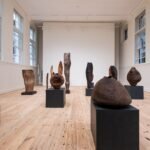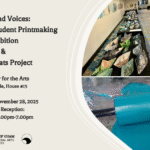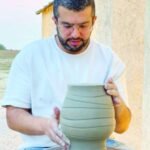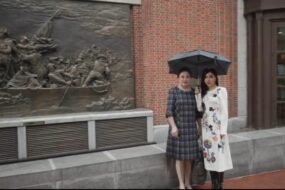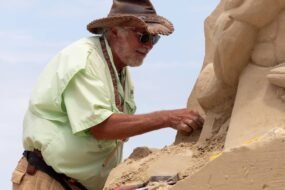
Interview conducted by Christopher Campbell
In Hennessy’s latest collaboration, French contemporary artist, Jean-Michel Othoniel, turns classic decanters into treasurable artifacts. The creative is most esteemed for his carefully crafted sculptures and hand-blown glass units. In his newest project, he famously joins artists like Tom Dixon, Frank Gehry, and Kim Jones, stepping into the world of historic collaborations with the household cognac name. Hennessy CEO, Laurent Boillot, says, “Working with esteemed artists, designers, and architects worldwide is an integral part of Maison’s identity and history. It reaffirms our dedication to creativity and craftsmanship. Our collaborating with Jean-Michel Othoniel elevates our XO collection, infusing it with his masterful use of light, colour and crystal.”

The partnership is fulfilled through the launch of two soon-to-be collectible items: the Hennessy X.O Masterpiece and the Hennessy X.O Limited Edition. The former is crafted from Baccarat crystal, consistent with the artist’s affinity toward the works of light and reflection. The decanter’s hand-carved French oak wood sends a warm-hearted nod to the iconic Hennessy barrels. The endeavor is his most unique: bottles that are both functional and decoratively artful.
On this venture, Othoniel says, “we’ve created two distinct limited-edition carafes, each a testament to the power of reimagining familiar objects with new meaning and beauty. Immersing myself in the artistry of barrel-making and cognac production was a profound experience, reinforcing my admiration for Hennessy’s legacy of craftsmanship and dedication.”

The X.O. Limited Edition design further elevates this concept, functioning as a shining gem inside its gold encasing. The structure’s sharp angles work to reflect light and create a vivacious feel. As per Hennessy’s commitment to sustainability, the decanter is also designed to be easily refillable and replaceable. Both lines launched in the US on September 18th.
The ongoing Hennessy X.O. x Jean-Michel Othoniel press tour provided a rich, versatile journey, one that begun at Othoniel’s personal art workshop (where this interview took place). The trip continued through the Distillery of the Domaine du Peu, where the wine is transformed into eaux-de-vie. At L’Atelier de Tonnellerie, the cooperage workshop, the artist got to witness the behind-the-scenes of high-quality oak wood barrel-making to understand the intricacy of wood’s effect on the spirit’s flavor palate.
In this interview, Christopher Campbell, Fashion Director at FLAUNT, spoke to Jean-Michel Othoniel about his creative process, the mastery behind melding tradition with novelty, and the nostalgia of working with the cognac staple.

Thank you for taking the time. So, my first question is, what has surprised you in the process of working with Hennessy on this limited release?
Freedom. Freedom of doing exactly what I want. To propose images, ideas, texture, material and to build this project together. They really make it possible, in fact. So this was really something interesting for me. To be totally free and to develop a project with new techniques, new material, and new mediums that I was not using before. Like the wood, for example, or the aluminum— using it as a facet, like we were using it. So it was really something very exciting. And also, what was really surprising, it was the creativity of NSE team. You imagine they are a big team of people who love art, who know art, who want to work around this idea of making a very special object. So it was a very exciting moment, but it was two years of work.
Now, would you say, were there some things that were quite challenging? Like maybe surprises that came up along the way, in terms of the new materials that you were using, or what were some of the most challenging aspects of designing it?
The most challenging is to make a real sculpture, but at the same time something you can use, you know, in a practical way. So this was very interesting to share about, what is a bottle? Very simple question, but how do you use it? Do you want to refill it or not? Do you want to be sustainable or not? So all those questions were linked to the idea of products, ideas I don’t have to face when I’m making an artwork. It was really interesting this challenge to do something— real artwork able to enter the arms of the people who want to connect.

Sure. What is it you feel when you arrive to Cognac? What sort of nostalgia or emotions does it arise to you?
It’s a very interesting place in France, because it’s a place where people are not working for today. It’s a place where they are working for the future, because they are doing some different things, and then they will blend them to make the Cognac. So you have people who work to make things that will be used in 10 years or in 50 years, or in 100 years. So they they maybe won’t see the realization of what they are working on. And this is very interesting in a conceptual way because you work not for today. You work for this idea of transmission. But everything starts from the earth, from the beauty of the vineyard, of the flavor of the different wood they are using to store the wine (the wine they are using at the beginning). So it’s a world by itself, you know. So you are entering a world. You enter with this historical family, and you can meet so many different craftsmen also. And those people who carve the wood were the ones I was very impressed by, because they have a tradition of carving the wood to make the barrel, and it’s beautiful to see how they change the shape of the wood using fire. You will see that. And the place where they’re working now, they redid it some years ago. And it’s very beautiful. It’s like they’re working in the museum doing performance, right? So they can also have people looking at them when they are working. It’s a very fascinated type of craft I didn’t know before. So that’s why I wanted to do something in wood to really pay homage to those guys. And you can connect also with the story of this place in France, because it’s close to the sea. So those people were working at the beginning of the boat. So it’s the same, people who were building the boats who were building the barrel. Also, because of the flavor you have in the wood, it will give flavor to what you put inside. So if it’s oak, it’s not the same taste. It’s another type of food. So it’s very interesting and very moving to see all those things. You will see the barrels from 200 years ago. Well, here and there, because if they want to redo the same recipe like they did 50 years ago, they need to go back to the same elements.
So it’s like an archive.
Yes, yes. Archives and what is more the idea of blending the thing.

Very cool. You’ve worked with numerous institutions and entities. What is special about intersecting with the spirit?
In fact, when I started to work with Hennessy, it was 17 years ago for the first edition we did together, and it was a 40-year anniversary of Mr. Hennessy. So it was more the idea to be connected with a unique person— 100 years old, you know, and to make something able to connect with this, historical personage. And so it was more like entering a family than entering a business, in fact. And I kept this feeling, and when they called me back 17 years later, I’d say, Okay, I have such a good memory of this moment, of this unique moment we worked together. I’m thrilled to try to do something different and maybe more open to the public because the first edition we did was very limited, just 100 and now we did a larger edition.


How does your artistic practice relate at present to French identity, or does it? Do you feel there are aspects in your output that read decidedly French?
Fortunately and unfortunately, I’m very French. I think there is this idea of poetry and this is very important in my work. And this is very French and but as I say, I travel a lot, so my work is also totally French, but totally international at the same time. What is great and what is a big challenge now as an artist, not for just for French artists but for artists all over the world, is to have a strong identity, and at the same time have work that’s able to talk to the entire world. So I feel lucky to have traveled so much because I built this bridge with a different culture. So my work is open enough to connect with the world— different countries, different ways to live, different religions, different approaches to life.
Yeah, it’s a good thing. You have enjoyed public art commissions. What is special about the public interacting with your art on a daily basis. How do you feel it differs from a gallery or museum?
I think it’s complementary. It’s important to show in galleries and museums and to have a dialogue with this idea of being in touch with what is the art world today, with the people who are the ones who think, what is the thinker of the contemporary art, the writer. And it’s important to be connected through museums and galleries. But also, what I deeply, really deeply and definitely think is that I want (and we need) to be connected to the public of the street. So as an artist, I had this feeling sometimes like I need to go to the streets and give public art space. It’s also giving artwork for free for everybody, for people who never enter a museum, for people from different backgrounds and different cultural environments. So it’s something very important for me, to be connected to reality and not just to this bubble of the art world. So that’s why it’s very complementary.

Please share a special memory from your time spent with the Hennessy team, either in preparation for the collaboration or in the execution of the final project itself.
In fact, I think we were really on the same page of the idea of making something perfect and beautiful with a very specific realization, discovering new techniques together. We start with my drawings, and we try to find the right new material to do it. So it was really a challenge for them and for me. Maybe the most amazing moment was the moment where we went to Baccarat to work on the colors, to work on the sensuality of the colors. Also, the technicians cut the glass and turned those glass elements into gems or jewelry. So it was really something very, very challenging for me because it was close to the glass. It was something I really enjoy. And also, to go in the factory, to work in this huge factory where it’s not easy as an artist to enter, but because this project was a very big project, and a large project, we were able to enter this factory and to work with the teams, which was great.


